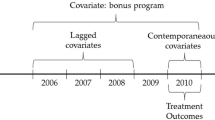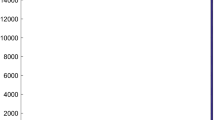Abstract
Pauly's analysis of the welfare effects of moral hazard assumes that consumption of health care does not increase with income, however, empirical evidence suggests it does. For health insurance contracts that pay off by reducing price, the income effect is represented by the additional health care consumed because of income transfers from those who remain healthy to those who become ill. This implies a different decomposition of demand than the standard Hicksian decomposition. When the effect of income transfers is removed, the price-related welfare loss is smaller than either the loss suggested by Pauly's analysis or a Hicksian decomposition.
Similar content being viewed by others
References
Arrow, K. J. (1963). “Uncertainty and the Welfare Economics of Medical Care. ” American Economic Review 53, 941–973.
Berk, M. L. and A. C. Monheit. (1992). “The Concentration of Health Expenditures: An Update. ” Health Affairs 11(5), Winter, 145–149.
Blaug, M. (1985). Economic Theory in Retrospect, Fourth edition. Cambridge, UK: Cambridge University Press. de Meza, D. (1983).
De Mesa D. (1983) “Health Insurance and the Demand for Medical Care. ” Journal of Health Economics 2(1), March, 47–54.
Ehrlich, I. and G. S. B. (1972). “Market Insurance, Self-Insurance and Self-Protection. ” Journal of Political Economy 80, 623–648.
Economic Report of the President: Transmitted to Congress February 1998. Washington, DC: U.S. Government Printing, 1998.
Feenberg, D. and J. Skinner. (1994), “The Risk and Duration of Catastrophic Health Care Expenditures. ” Review of Economics and Statistics 76, 333–347.
Feldman R. and B. Dowd. (1991). “A New Estimate of the Welfare Loss of Excess Health Insurance. ” American Economic Review 81(1), March, 297–301.
Feldstein, M. S. (1973). “The Welfare Loss of Excess Health Insurance. ” Journal of Political Economy 81, March/April 251–280.
Feldstein, M. and B. Friedman. (1977). “Tax Subsidies, the Rational Demand for Insurance, and the Health Care Crisis. ” Journal of Public Economics 7, 155–178.
Friedman, Milton. (1962). Price Theory: A Provisional Text. Chicago: Aldine Publishing Co.
Hausman, J. A. (1981). “Exact Consumer's Surplus and Deadweight Loss. ” American Economic Review 71, 662–676.
Hirshleifer, J. (1976). Price Theory and Applications. Englewood Cliffs, NJ: Prentice-Hall.
Hicks, J. R. (1946). Value and Capital (2nd edition), Oxford: Clarendon Press.
Lefkowitz, D. and A. Monheit. Health Insurance, Use of Health Services and Health Care Expenditures (AHCPR Pub. No. 92–0017). National Expenditure Survey Research Findings 12, Agency for Health Care Policy and Research. Rockville, MD: Public Health Service.
Manning, W. G., J. P. Newhouse, N. Duan, E. B. Keeler, A. Leibowitz and M. S. Marquis. (1987). “Health Insurance and the Demand for Medical Care: Evidence from a Randomized Experiment. ” American Economic Review 77(3), June, 251–277.
Manning, W. G. and M. S. Marquis. (1996). “Health Insurance: The Tradeoff Between Risk Pooling and Moral Hazard. ” Journal of Health Economics 15(5), October, 609–640.
Manning, W. G. and M. S. Marquis. (2001). “Health Insurance: Tradeoffs Revisited. ” Journal of health Economics
Mishan, E. J. (1971). Cost-Benefit Analysis: An Introduction. New York: Praeger.
Mishan, E. J. (1981). Introduction to Normative Economics. New York: Oxford.
Newhouse, Joseph P. (1992). “Medical Care Costs: How Much Welfare Loss?” Journal of Economic Perspectives 6(3), Summer, 3–22.
Nyman, J. A. (1991). “Costs, Technology, and Insurance in the Health Care Sector. ” Journal of Policy Analysis and Management 10(1), Winter, 106–111.
Nyman, J. A. (1999a). “The Value of Health Insurance: The Access Motive. ” Journal of Health Economics 18(2), April, 141–152.
Nyman, J. A. (1999b). “The Welfare Economics of Insurance Contracts that Pay Off by Reducing Price. ” Discussion Paper No. 308. Center for Economic Research, Department of Economics, University of Minnesota: Minneapolis, April.
Nyman, J. A. (1999c). “The Economics of Moral Hazard Revisited. ” Journal of Health Economics 18(6), December, 811–824.
O'Connell, J. F. (1982). Welfare Economics Theory. Boston: Auburn House.
Parkin, D., A. McGuire and B. Yule. (1987). “Aggregate Health Care Expenditure and National Income: Is Health Care a Lusury Good? Journal of Health Economics 6(2), June, 111–127.
Pauly, M. V. (1968). “The Economics of Moral Hazard: Comment. ” American Economic Review 3, 531–537
Slutsky, E. E. (1952). “On the Theory of the Budget of the Consumer. ” Translated by Olga Ragusa and reprinted in Reading in Economic Theory. Homewood, IL: Irwin.
Varian H. R., (1984). Microeconomics Analysis. New York: Norton.
Viscusi, W. K. and W. N. Evans. (1990). “Utility Functions that Depend on Health Status: Estimates and Economic Implications. ” American' Economic Review 80, 353–374.
Willing, R. D. (1976). “Consumer Surplus Without Apology, ” American Economic Review 66(4), September, 589–597.
Zeckhauser, R. (1970). “Medical Insurance: ACase Study of the Tradeoff between Risk Spreading and Appropriate Incentives. ” Journal of Economic Theory 2, 10–26.
Zweifel, P. and F. Breyer. (1997). Health Economics. New York: Oxford.
Author information
Authors and Affiliations
Rights and permissions
About this article
Cite this article
Nyman, J.A., Maude-Griffin, R. The Welfare Economics of Moral Hazard. International Journal of Health Care Finance and Economics 1, 23–42 (2001). https://doi.org/10.1023/A:1011547904553
Issue Date:
DOI: https://doi.org/10.1023/A:1011547904553




